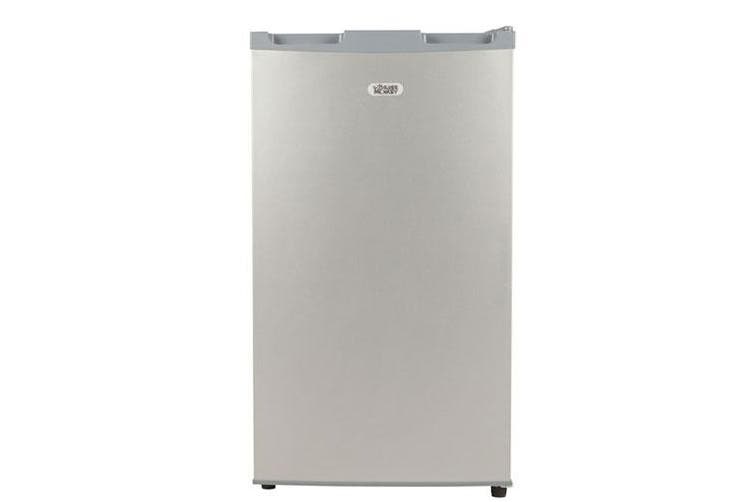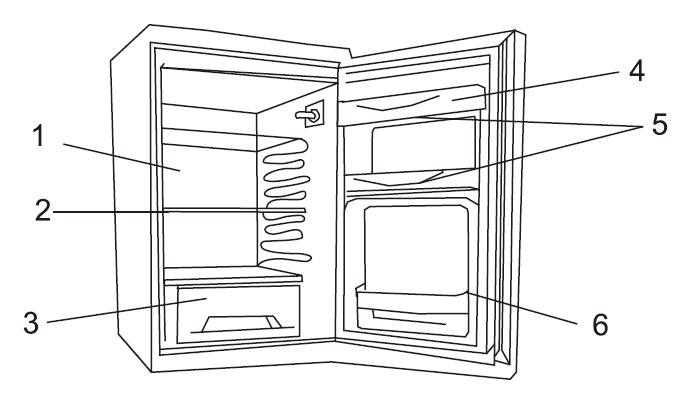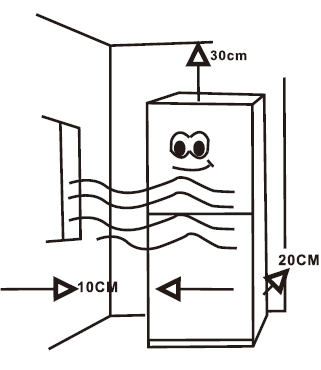Brass Monkey Upright Fridge

SAFETY INSTRUCTIONS
WARNING:
- Do not touch exposed cables with your bare hands when operating the appliance.
- It is dangerous to touch the plug when your hand is wet. When using the refrigerator in a vehicle or boat, please make sure the power source is fused (ie has a fuse protecting the input power).
- The installation of a wired DC power source should be handled by qualified person.
- Make sure the input voltage is correct. Check technical data label
- Do not place any electrical devices inside the refrigerator.
- Please keep the fridge away from substances which can cause fire or and ignition source.
- The appliance is not intended for use by young children or infirm persons unless they are adequately supervised by a responsible person to ensure that they can use the unit safely. Young children should be supervised to ensure that they do not play with the appliance.
PLEASE NOTE:
- Your refrigerator requires good ventilation, especially around the back of the unit. Allow a gap of at least 200mm around the back and 100mm around the right.
- Avoid humidity. Humidity inside the appliance can form frost and impair cooling. Therefore, defrost it before this happens. Never clean the appliance under running water or in dish water.
- Avoid placing your refrigerator near a heat source. This helps the refrigerator work more efficiently and keep contents cool.
- Place the refrigerator on a flat surface and away from any edges. When placing the refrigerator into the car, please use the belt to fasten it securely.
TROUBLESHOOTING
- Check the power supply
- Ensure the plug and the socket have a good connection.
- Check the fuse is OK and not burned out
- Has the appliance been turned on?
- The food inside is frozen
POOR REFRIGERATION PERFORAMNCE:-
- Has too much food been placed inside the refrigerator?
- Is the door seal broken?
- Problems arising from poor ventilation?
- There is no room around the appliance
- There is a heat source nearby
- The temperature setting is incorrect
If you observe the sound of water internally – This could be the flow of the refrigerant.
- Other Noises – The refrigerator is not placed on a level surface Touching the wall or something else
- Parts may have dislodged from the interior of the refrigerator
CLEANING & MAINTENANCE
- Be sure to disconnect the input power before cleaning the fridge.
- Clean the appliance inside and out with a damp cloth once a week. If it is dirty, using sodium bicarbonate dissolved in lukewarm water can be used to clean.
- Never use abrasive products, detergents or soap. After washing, rinse with clean water and dry carefully. Do not leave the refrigerator shut off, warm inside or with food inside or lid closed.
- Never clean the appliance under running water or in dish water. Do not use abrasive cleaning agents or hard objects during cleaning as these can damage the refrigerator.
DEFROSTING
- After the refrigerator has been working for a period of time frost could develop on surfaces of the freezer, which reduces the refrigerating effect and increases power consumption.
- Defrost directions:1. Unplug the refrigerator and open the door, remove the contents (food/drink) from the refrigerator.2. Use a plastic defrosting shovel or plastic scraper to remove ice and frost (Or alternatively you can just leave the door open to allow the ice and frost to melt).3. Then use a cloth or towel to wipe away the water and ice.4. After that, place the food back to the refrigerator and plug in. Note: – Do not use sharp metal tools to defrost which will damage the refrigerator.
THE FOLLOWING SITUATIONS ARE NORMAL
- The flow of refrigerant through the evaporator may create a boiling or gurgling sounds.
- When it is raining outside and there is high humidity, moisture may form on the outside of refrigerator or near the door gaskets. You can wipe any damp surfaces with dry cloth.
- The temperature on the back panel and doorframes maybe high (particularly in summer) due to the heat emission of the condenser and defrost heater.
- The temperature on external surfaces of the compressor maybe high when the compressor is working.
- The compressor may cause a high hum or pulsating sound when it is at starting or stopping step.
- When the refrigerator is working some dew or frost may be found on back panel inside the refrigerator.
Please read these instructions and safety section carefully before using your refrigerator.Keep the instructions for future reference.
STRUCTURE OF REFRIGERATOR
(Because this manual is used for several models, some features and devices shown in the below figure may not contained in your refrigerator.)
(Drawer Type)
- Refrigerator
- Shelves
- Fruit and Vegetable Crisper
- lce tray
- Bottle rack
- Door
PRODUCT OVERVIEW
This refrigerator contains two compartments with different temperatures. The refrigerator section is used to refrigerate fruit, vegetable, eggs milk and so on. The Freezer compartment is used for frozen food such as fish, meat, making ice and so on.
This refrigerator adopts a flat back panel design and has elegant and graceful appearance.
PREPARATION BEFORE USING
- When moving the fridge, ensure it is tilted no more than 45 degrees and handle carefully.
- Do not use the door handle to lift the refrigerator.
- Do not invert, throw or drop the refrigerator .
- Do not en lace the power cord or put it under furniture or any heavy weight. Keep the power cord away from heat sources (such as the compressor) .
- Rated power supply: 12V/24V DC;
- The power supply wire cannot be lengthened. Ensure the power cable is kept in good order. Do not enlace the wire or put it under furniture or other heavy items. It is advised that wire is NOT put near the compressor due to it’s high temperature at times.
- If the power supply wire is damaged then please go back to the store of purchase to buy another.
- The refrigerator must be placed in dry, cool, and ventilated place which is far from any heat source (such as a stove, or flue) and avoid direct sun light.
- Allow for space around the fridge for good air circulation (see the left figure):
- Top: 30cm Sides: 10cm Back: 20cm
- Place the refrigerator on a floor that is flat and strong enough to support it when It’s fully loaded. If the floor is not flat enough, then adjust the feet (shown in figure I) to level the refrigerator. When not level it will cause vibration and noise.
- If the refrigerator is placed on carpet, please place wooden boards under the refrigerator. Or the hot air produced by compressor may discolor the carpet.
Placement
OPERATING INSTRUCTIONS
- Unpack the fridge, remove the carton and place the refrigerator as per installation instructions.
- Although the refrigerator has been cleaned before leaving the factory, we strongly recommend to use soft cloth dampened with warm water and a little neutral detergent to clean it again. After that wipe it with a dry soft cloth. (Warning: Electrical parts can be wiped by a dry cloth only)
- Plug in the refrigerator and open the door. You will see the light in the refrigerator is on. Set the thermostat button at 3 to start compressor After 30 minutes, open the freezer door. When you feel the temperature is obviously decreasing, the refrigerating system works properly. After the refrigerator works for a while, the thermostat will keep the temperature in setting range automatically.
- For first time use, please put foods into the refrigerator after it cools down.
FOOD STORAGE
Freezer (Below-1 S”C)
- Meat should be cut and wrapped tightly, and then evenly placed in the freezer.
- After buying frozen food, put it in the freezer whilst it is still in frozen .
- Do not put the fresh food and frozen food together.
- Do not put the fruit and vegetable in the freezer in order to avoid freeze-drying.
- Do not put a glass container or other container with a sealed lid that contains liquid into the freezer. Or there is a possibility of explosion as the liquid freezes and expands .
Refrigerator (0 °C~5° C)
- Eggs, butter, milk and bottled drinks can be put in the refrigerator. Fruit and vegetables should be put in the crisper for moisture retaining.
- Hot food should be cooled down before its placed into the fridge or freezer, which could help to save power.
- Food should be packed into zip lock or vacuum packed bags. Leaving space between these items to allow the circulation of cool air between them.
Quick-freezing
- Food is frozen by a rapid process to retain natural flavor and nutritional value.
- Quick-freezing is better than normal-freezing for Meat storage.
- To start quick-freezing, you must set the temperature control at 6~7 and put the food in the middle of the freezer. After quick-freezing finishes set the temperature control back to normal position.
TEMPERATURE CONTROLLER 
- The temperature is controlled by a thermostat in the refrigerator. “l”is least cold and “?”is most cold. You can adjust it according to your requirement. A setting of 0 will force the refrigerator to stop.
- You can set the temperature controller at proper position according to the ambient temperature and the amount of contents loaded into the refrigerator.
- Normally, we recommend setting it at”3~?4″considering the balance between keeping food fresh and saving energy.
- In winter the indoor temperature maybe below 1 0’C. If the refrigerator does not start or work properly, please turn on the compensatory switch shown in the picture on the left This will make the refrigerator work properly.
- When the indoor temperature warms up or abnormal ice crystals appear on surfaces in the freezer please turn off the switch shown in left figure.
[xyz-ips snippet=”download-snippet”]




